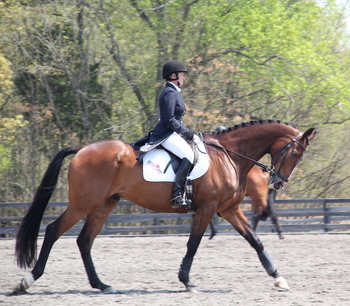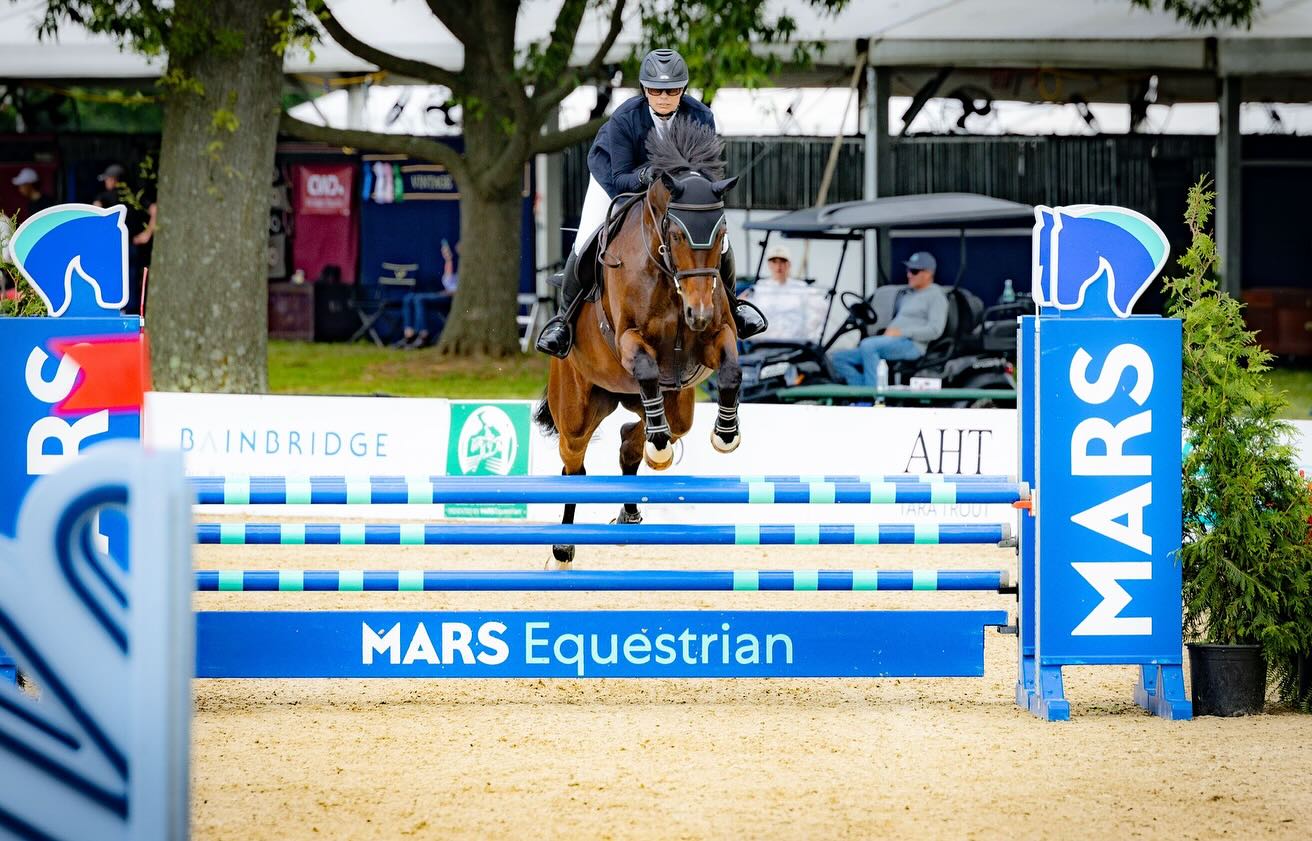At the beginning of the year, Riders4Helmets organised a safety symposium down in Wellington, Florida which brought together not only many experts within different disciplines of horse sports, (racing, polo, jumping, eventing, dressage…) but also David O Connor and John Long representing the USEF, helmet manufacturers, and two esteemed experts in brain injuries and trauma: Dr. Allen Sills from the Sports Concussion Center at Vanderbilt University, and Dr. Craig Ferrell, the FEI medical Chairman and US team physician. This may have been the first time in the world that such a diverse group of horsemen and women met in one room with one common goal – rider safety; and the results are ongoing and impressive.
Keeping your head
In March a new rule came into effect in the US that anyone at all USEA recognised events must wear an approved helmet with a safety harness at all times when mounted. Dressage soon followed suit, and British Dressage is currently debating the issue.
At the Rolex Kentucky Three Day Event this year, the USEF started the first phase of a new scheme to improve rider safety; in partnership with the Sports Concussion Center at the University of Vanderbilt the riders were offered free baseline “imPACT” testing, in an effort to start to bring eventing in line with all professional sports that have implemented formal concussion programs to bring standardized managament to brain injuries.
The goal of the testing is to create a baseline “snapshot” of each athlete, akin to a thumbprint, and consists of a brief questionnaire on their concussion and neurological history, a baseline computerized cognitive test (ImPACT), and a brief balance assessment. The tests took about half an hour. All this in an effort to provide the best possible care in the event of a fall involving head trauma, and to allow each individual rider to return to competition as safely and quickly as possible.
Dr. Allen Sills was available all day on the thursday of Rolex to carry out the tests, and gave his own cell phone number to all the riders that participated, fifteen in total. He told me they probably would have tested more riders if he’d had more time, but the USEF is now planning to extend the service at some other events.
“I was very pleased with the level of enthusiasm among the riders, they were extremely pleasant and co-operative; I think all of them were familiar with the testing and were eager to partner with us in helping them with these injuries. I would say that I was somewhat surprised at the number of concussions that most of the riders had suffered. I take care of a lot of professional athletes in a lot of different sports, but as someone fairly new to the discipline of eventing I was fairly surprised at how many concussions a lot of these riders had suffered through their careers and that just re-inforced in my mind the importance of this program and this partnership.”
Participation in the program is completely voluntary, and not binding for participation in competitions. Rather, it’s an effort to make sure that elite equestrian athletes have access to the same level and type of care that is available to other professional athletes who suffer concussions and related injuries. For example, the ImPACT testing program is currently used by all of the NFL, NHL, and MLB teams, as well as many NBA teams and almost all Division 1 varsity college athletic programs. Dr Sills was full of praise for everything the USEF is doing in it’s attempts to increase rider safety.
“We wanted to start out by doing the testing for the elite level athletes who are most likely going to be associated with the US teams, and we’re trying to help the USEF make sure that those athletes have access to concussion care that is equivalent to that which would be received by professional athletes in other sports. Another big part of the efforts of the USEF is getting the word out about safety precaution, concussion diagnosis, and management throughout the eventing world. It’s very similar to bicycling in some ways; helmet use was not mandatory in the Tour de France bike race until just a few years ago after there were some very severe crashes, but as more and more of the professional cyclists began to use helmets, and it began to be mandated by their national governing bodies, then you saw an even greater increase of helmet use among recreational bike riders. That’s where the USEF should be commended because what they’re trying to do is take the professional elite riders, and have them demonstrate leadership in this area.”
Allison Springer, who competed two horses at Rolex this year, and who rather famously now, rode into 2nd place last year after dressage on Arthur, wearing a helmet as one of only 3 riders I believe to do so, and again into 3rd place after dressage this year, was one of the riders who participated. She told me she signed up for the test the day before, and thinks it’s a great idea, as the return to play call is such a hard and personal one to make. This way, the results of her test will be in a database, and should she have a fall and be concussed, or have any kind of head injury, she can have an assessment based on a ‘before and after’ picture. Allison said the testing consisted of a health questionnaire, a balance test, some memory quizzes, speed and summary questions, and some computer tests; she said it would have been impossible to manipulate the outcome, and that she’d had an idea of what to expect having attended the Safety Symposium in January.
Phase 2 and 3 of the scheme will be to offer the testing to any rider who chooses to have it, for a fee of $75, and the USEF hopes to extend the testing to the other FEI disciplines also. However you can do portions of the test online, although Dr. Sills warns me,
“There are a number of providers around the country that offer this testing, and I think it’s terrific for athletes who are involved in sports like eventing to try and get a baseline test through one of these providers because that can only help them if they do suffer an injury. However, it’s not something where an individual rider can do the test online on their own, get feedback and plan their care without the input of a concussion professional.”
The riders tested were provided with an information card containing contact information for the Vanderbilt Sports Concussion Center elite athlete hotline. Riders may contact one of the experts directly at any time in the future should they suffer a neurologic injury. The VSCC expert will then assist the athlete in management of their concussion with special emphasis on return to competition decisions. It is hoped that this will replace the arbitrary rules that currently exist for return to competition after concussion, where a set number of days or weeks can be meaningless to any individual.
Dr. Sills stressed why the baseline test will be so enormously helpful,
“Each individual has a performance on certain neuro-psychological tests of visual, verbal and spatial memory and all these different components of memory. Each individual’s performance is their baseline, so what we’re trying to do is establish that baseline in terms of their performance on the testing and also their baseline balance and vestibular function. The idea then is if they were to suffer an injury, then we could go back and compare brain performance, and that will allow us to help understand when they have fully recovered.
So what we were doing was getting baseline testing of the cognitive measures, as well as balance and co-ordination assessments and baseline history data about neurological conditions and previous concussions because all of those factors have to be taken into consideration to help us understand future injuries, and consequent recovery.
In almost all concussion injuries, MRI and CT scans are normal, because they are scans of structure and not function. Concussions are usually not injuries that cause structural change in the brain, at least at the level we can see on a scan. Concussions are injuries that cause change in brain function, so in the overwhelming majority of cases a CT scan or MRI will be normal, but that person may still have a very severe brain injury. That’s why we need other ways to assess brain function.”
I’d like to thank Sara Ike, the Managing Director of Eventing at USEF for all her help with this article, and also Dr. Allen Sills for his time and patience in explaining the basics to me, and Allison Springer for describing the test and talking about it openly. I especially want to mention Lyndsey White who runs Riders4Helmets in her spare time, and at personal expense, out of the kindness of her heart, and who was instrumental in getting the ball rolling. I do wear a helmet now, thanks to her campaign, as do many others, so thank you, Lyndsey, and thank you for reading. Strap one on, and go eventing!
Subscribe
Login
Please login to comment
0 Comments


























